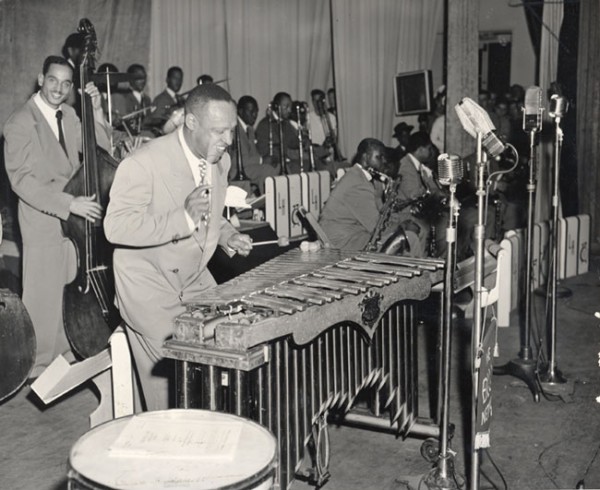Lionel Hampton (1908-2002) was an American jazz vibraphonist, pianist, percussionist, bandleader, and composer who played a pivotal role in the development of jazz from the swing era through the bebop era and beyond. He is widely regarded as one of the greatest jazz vibraphonists of all time and was a key figure in bringing the vibraphone to prominence as a jazz instrument. Hampton’s career spanned over six decades, and he collaborated with many of the most notable jazz musicians of his time, influencing generations of musicians with his energetic performances and innovative techniques.
Overview of Lionel Hampton
- Early Life and Career Beginnings: Born on April 20, 1908, in Louisville, Kentucky, Lionel Hampton moved to Chicago at a young age, where he was exposed to the vibrant jazz scene. He started his career as a drummer and pianist, performing with various bands. Hampton’s introduction to the vibraphone came in the late 1920s while playing with the Les Hite band in Los Angeles. After being introduced to the instrument, he quickly mastered it and began to incorporate it into his performances, revolutionizing its use in jazz.
- Breakthrough with Benny Goodman: Hampton’s big break came in 1936 when he was invited to join the Benny Goodman Quartet, which became one of the first racially integrated jazz groups to perform publicly. The group’s innovative approach to swing music, combined with Hampton’s vibrant vibraphone solos, made them immensely popular. His work with Goodman on tracks like “Flying Home” and “Dinah” showcased his unique ability to blend rhythmic complexity with melodic improvisation.
- Formation of the Lionel Hampton Orchestra: In 1940, Hampton formed his own big band, the Lionel Hampton Orchestra, which became one of the leading swing bands of the era. Known for its high-energy performances and virtuosic musicianship, the band produced several hits, including “Flying Home,” which featured a groundbreaking tenor saxophone solo by Illinois Jacquet that became a precursor to the bebop style. Other notable tracks include “Hamp’s Boogie Woogie,” “Hey! Ba-Ba-Re-Bop,” and “Midnight Sun.”
- Innovations and Versatility: Hampton’s career was marked by his versatility and innovation across various jazz styles. While he was a swing era giant, he was also open to the developments of bebop, modern jazz, and even rhythm and blues, making his work dynamic and diverse. He was an accomplished multi-instrumentalist, known not only for his vibraphone playing but also for his drumming, piano skills, and vocal work. His ability to cross genres and influence emerging jazz styles contributed to his lasting impact on the jazz world.
- Later Years and Legacy: Throughout the 1950s, 1960s, and beyond, Hampton continued to lead his band and tour internationally, becoming an ambassador for jazz around the world. He performed for several U.S. Presidents, including Dwight D. Eisenhower, Richard Nixon, and George H.W. Bush. In his later years, Hampton became more involved in education, founding the Lionel Hampton School of Music at the University of Idaho in 1987, which was the first university music school named after a jazz musician.
Impact on Music and Culture
- Pioneering Vibraphone in Jazz: Lionel Hampton is credited with making the vibraphone a prominent instrument in jazz. Before Hampton, the vibraphone was not widely used in the genre, but his innovative techniques and melodic approach made it a staple in jazz music. He influenced a wide range of musicians, from Milt Jackson of the Modern Jazz Quartet to contemporary vibraphonists like Stefon Harris.
- Promoting Racial Integration in Jazz: Hampton’s work with Benny Goodman in the 1930s as part of one of the first racially integrated jazz ensembles helped break down racial barriers in American music. This was a significant step toward greater acceptance of integrated bands during a time when racial segregation was still prevalent in the United States.
- Influence on Swing and Bebop: Hampton’s music helped bridge the gap between the swing era and the bebop era. His big band arrangements and performances incorporated both the danceable, melodic elements of swing and the improvisational complexity of bebop. His song “Flying Home” is often cited as one of the earliest examples of the bebop style and had a significant influence on the genre’s development.
- Educator and Jazz Advocate: Later in life, Hampton became a key advocate for jazz education and preservation. The Lionel Hampton Jazz Festival, held annually at the University of Idaho, became one of the most respected jazz festivals in the United States. His efforts in education have helped sustain jazz as an art form and inspired future generations of musicians.
- Enduring Influence: Hampton’s energetic performance style, innovative approach to the vibraphone, and contribution to the integration of jazz remain influential. His work continues to inspire jazz musicians, and his recordings are considered essential listening for understanding the evolution of jazz from the swing era to modern jazz.
Lionel Hampton Jazz Legends Playlist:
1
/
2
EG
Glad Hamp
Little Girl Blue
Them Changes
Groovin Gates
I Loves You Porgy
Psychedelic Sally
Tired Of Being Alone
Ain't No Sunshine
Bad Dude
Raunchy Rita
What's New
California Dreamin'
Fum
Prelude To A Kiss
1
/
2
Lionel Hampton – Topic – YouTube Channel:
https://www.youtube.com/channel/UCpfWWFslWSapwL_q16AboSg
References
- Chilton, John. Lionel Hampton: Music, Life, and Legacy. Da Capo Press, 1980.
- Gioia, Ted. The History of Jazz. Oxford University Press, 1997.
- Goodman, Benny, and Lionel Hampton. Benny Goodman and the Birth of Swing. University of Chicago Press, 1988.
- Rockwell, John. “Lionel Hampton, Who Put Swing in the Vibraphone, Is Dead at 94.” The New York Times, August 31, 2002.
- University of Idaho. “Lionel Hampton School of Music.” University of Idaho, 1987.


Leave a Reply